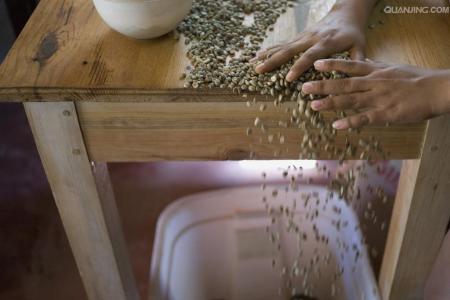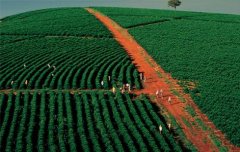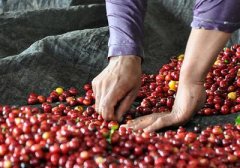A brief introduction to the Origin, Development, History and Culture of Hawaiian Fine Coffee beans full of Flower scent

Of all the coffee producers, Hawaii has the most stringent management of the coffee industry, the highest labor costs and the best level of investment.
Hawaii's coffee industry has to compete with the expanding tourism industry. Most coffee is grown on the slopes of MaunaLoa. Mauna Loa was originally a volcano located in the western part of the Kona region on the island of Hawaii. The coffee producing area is about 30 kilometers long and its growing areas are mainly concentrated in the north and south of the area. Coffee trees are planted in relatively desolate areas, but their soil is fertile and contains volcanic ash. Although it takes a lot of physical labor to start planting and it is difficult to manage, it is comforting that Kona's coffee trees (at least those growing above 90 meters above sea level) do not seem to be affected by any diseases and insect pests.
Real Kona coffee is indeed a treasure in the world and is not easy to find. The best Kona coffee is divided into three grades: ExtraFancy, Fancy and NumberOne. This third-class coffee is produced on manors and under natural conditions. Most of the coffee on the market that calls itself "Kona" contains less than 5% of the real Hawaiian Kona coffee. Another good Hawaiian coffee can be found in the United States-Hawaiian Kaj Farm Coffee (KaiFarms).
The smell of Hawaii
In Hawaii, you can watch the fiery sunset sink into the red-orange sea, feel the fresh air filled with the scent of flowers, and sit by the sea and drink a cup of Kona coffee. I'm afraid there's no place in the world that can offer you such enjoyment.
The most famous university in Wayi State is Hawaii State University (University of Hawaii). Its main school districts are: Hilo, Manao and West Oahu. In addition, famous private universities in Hawaii include Brigham Young University in Hawaii (Brigham Young University-Hawaii Campus), Chamannard University (Chaminade University) and Hawaii Pacific University (Hawaii Pacific University) in Honolulu, and Loa College in Hawaii (Hawaii Loa College) in Oahu.
Traffic
City Traffic Map of Hawaii-the latest erlinyou version
City Traffic Map of Hawaii-the latest erlinyou version
Air traffic in Hawaii occupies a very important position, and the routes between the islands are mainly flown by two airlines: Hawaiian Airlines and Aloha Airlines. Honolulu International Airport ─ is the most important aviation pivot in the state, which terminates most routes to and from Hawaii in the United States, and transfers to other islands. There are also flights to big cities in Asia, such as Tokyo, Osaka, Nagoya, Seoul, Taipei, Sydney, Auckland and so on. [2]
Highway Honshu highway system is different from the United States, the numbering begins with H for identification, and does not follow the coding principles of even east-west direction and odd north-south direction, but uses the construction sequence as the coding basis. Three projects have been completed, all on the island of Oahu, namely, Hmur1, Hmur2 and Hmur3. [2]
Hawaii's most famous coffee bean and coffee producing area is Kona kona, which is located in the southwest of the Big Island, 20 miles long and 2 miles wide, covering the slopes of Hualalai and Mauna Loa. Only coffee beans grown in this area and subject to the most stringent certification standards can be sold under the trademark Kona. Today, about 100 farms have produced coffee beans that meet these standards, and more and more farms are expected to follow suit in the future. The Hawaiian Islands have long been recognized as a paradise on earth, and after nearly two centuries of efforts to grow coffee, the term Kona kona is almost synonymous with quality.
Now other Hawaiian islands are trying to catch up with Kona kona's high quality standards. Now Hawaii is really like Mark to many beach activities and coffee lovers. Twain's image is generally the most enjoyable place on earth, although all the islands in Hawaii have coffee trees grown for commercial purposes, but at present, the number of coffee farms on the big island is the largest, with about 650. but these coffee farms are relatively small, adding up to less than 2000 acres of planted woodland. There are only 25 coffee farms operating on the islands of Maui, Molokai, Oahu and Kauai, but they are much larger and produce more than three times as much as the Big Island. Surprisingly, Kauai Island has the largest coffee-growing area of any island, with more than 4000 acres, but all are managed by the same operator, while Molokai Island has only 550 acres of coffee-growing land, with even fewer Maui and Oahu. Most Hawaiian coffee farmers still pick fresh coffee cherries to sell today, but in recent years more and more people are committed to adding value to their coffee bean products. as a result, most of them go to their own post-processing, drying, grinding and baking their own coffee beans Hawaii spans latitudes 19 to 22 degrees, south of the Tropic of Cancer, the Hawaiian Islands, blown by trade winds, is a natural perfect coffee growing area. The 50th state of the United States, 2400 miles from the west coast of the United States, is the only state in the United States that produces coffee. Kona kona from Hawaii is also internationally renowned as one of the best coffee in the world. The volcanic soil and tropical climate, coupled with slight humidity and regular afternoon showers, create an ideal planting environment that only appears in idyllic poetry, and add some meticulous but unique flavor characteristics to the coffee beans here.
Major industries in the state of Hawaii include tourism, defense industry and agriculture. Pearl Harbor on the south bank of Oahu Island is the largest American military port in the Pacific Ocean; Honolulu, the state capital, is the industrial and commercial center of Xiazhou. [1]
Agriculture is the pillar of the local economy, producing sugar cane, pineapple, coffee, bananas and so on, of which pineapple production ranks first in the world. [1] Hawaii is suitable for the growth of sugar cane. Two-thirds of the land in the archipelago grows sugarcane, producing about 1 million tons of crude sugar each year. It is equivalent to 10% of the total sugar consumption in the United States each year, so it is called the sugar island of the United States. [4] Food processing is the main industry, with a few oil refining, chemical industry, cement and so on. Food and major industrial products are dependent on imports. Due to the pleasant climate and beautiful scenery, the tourism industry is well developed, with an average annual tourist volume of more than 7 million. Oahu is an area with a concentrated tourism industry. [1]
According to the Bank of Hawaii, the ripple effect of tourists' spending in Hawaii is 2, that is, for every $1 spent by tourists, it will increase the local total output value by $2. Tourism income accounts for 60% of the local gross domestic product, so that Hawaii's economic growth rate is always higher than the average economic growth level of the United States. [1]
As tourism plays an important role in Hawaii's economy, the Hawaiian state government attaches great importance to protecting the environment, protecting tourism resources, and paying attention to the development of "clean" industries. such as marine science, aquaculture, tropical agriculture, financial services, commercial centers, etc., in order to promote the development of tourism and promote economic development. [1]
Social editor
Population
In 2000, the resident population of the state of Hawaii was 1.212 million and the floating population was 1.334 million (including tourists). The Japanese are the largest Asian people in Hawaii, followed by Filipinos, natives, Chinese, Koreans, Vietnamese, Laos and Thais. The urban population accounts for 86.5%. About 80% of the state's population is concentrated on Oahu.
The most famous university in Hawaii is the Hawaiian State University (University of Hawaii). Its main school districts are: Hilo, Manao and West Oahu. In addition, famous private universities in the state of Hawaii include: Brigham Young University in Hawaii (Brigham Young University-Hawaii Campus); Chamanard University in Honolulu (Chaminade University) and Hawaii Pacific University (Hawaii Pacific University); and Hawaii Loa College in Oahu (Hawaii Loa Kona Coffee is indeed a worldly treasure and hard to find. The real Hawaiian Kona coffee has the sweetness of caramel, which makes people enjoy the unique pleasure and leads you slowly into the detached state of tasting coffee.
Important Notice :
前街咖啡 FrontStreet Coffee has moved to new addredd:
FrontStreet Coffee Address: 315,Donghua East Road,GuangZhou
Tel:020 38364473
- Prev

A brief introduction to the description of flavor, taste and aroma characteristics of Hawaiian boutique coffee beans with full water
Rizhao: the warm tropical sun plays an important role in the reproduction of coffee trees. Hawaii provides the morning light that Kona Coffee needs. Cloud cover: due to the rise of clouds at noon, the severe direct sunlight is ensured and stopped. Rainfall: cloud cover brought enough Rain Water, so that after a morning sun coffee, eager to enjoy the afternoon Rain Water's moisturizing baptism. Slope: good
- Next

A brief introduction to the market price of wet and smooth Hawaiian boutique coffee beans
Although Hawaii is often affected by tornadoes, the climatic conditions are very suitable for the coffee industry. There is plenty of rain and sunshine, and there is no worry of frost. In addition, there is a strange natural phenomenon called free shade. On most days, around 2 o'clock in the afternoon, white clouds appear in the sky, providing the necessary shade for the coffee tree
Related
- Detailed explanation of Jadeite planting Land in Panamanian Jadeite Manor introduction to the grading system of Jadeite competitive bidding, Red bid, Green bid and Rose Summer
- Story of Coffee planting in Brenka region of Costa Rica Stonehenge Manor anaerobic heavy honey treatment of flavor mouth
- What's on the barrel of Blue Mountain Coffee beans?
- Can American coffee also pull flowers? How to use hot American style to pull out a good-looking pattern?
- Can you make a cold extract with coffee beans? What is the right proportion for cold-extracted coffee formula?
- Indonesian PWN Gold Mandrine Coffee Origin Features Flavor How to Chong? Mandolin coffee is American.
- A brief introduction to the flavor characteristics of Brazilian yellow bourbon coffee beans
- What is the effect of different water quality on the flavor of cold-extracted coffee? What kind of water is best for brewing coffee?
- Why do you think of Rose Summer whenever you mention Panamanian coffee?
- Introduction to the characteristics of authentic blue mountain coffee bean producing areas? What is the CIB Coffee Authority in Jamaica?

